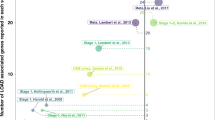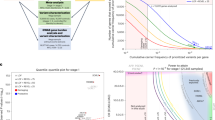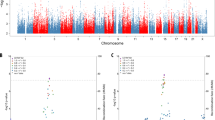Abstract
By analyzing late-onset Alzheimer's disease (LOAD) in a genome-wide association study (313,504 SNPs, three series, 844 cases and 1,255 controls) and evaluating the 25 SNPs with the most significant allelic association in four additional series (1,547 cases and 1,209 controls), we identified a SNP (rs5984894) on Xq21.3 in PCDH11X that is strongly associated with LOAD in individuals of European descent from the United States. Analysis of rs5984894 by multivariable logistic regression adjusted for sex gave global P values of 5.7 × 10−5 in stage 1, 4.8 × 10−6 in stage 2 and 3.9 × 10−12 in the combined data. Odds ratios were 1.75 (95% CI = 1.42–2.16) for female homozygotes (P = 2.0 × 10−7) and 1.26 (95% CI = 1.05–1.51) for female heterozygotes (P = 0.01) compared to female noncarriers. For male hemizygotes (P = 0.07) compared to male noncarriers, the odds ratio was 1.18 (95% CI = 0.99–1.41).
This is a preview of subscription content, access via your institution
Access options
Subscribe to this journal
Receive 12 print issues and online access
$209.00 per year
only $17.42 per issue
Buy this article
- Purchase on Springer Link
- Instant access to full article PDF
Prices may be subject to local taxes which are calculated during checkout

Similar content being viewed by others
Accession codes
References
Evans, D.A. et al. Prevalence of Alzheimer's disease in a community population of older persons. Higher than previously reported. J. Am. Med. Assoc. 262, 2551–2556 (1989).
Corder, E.H. et al. Gene dose of apolipoprotein E type 4 allele and the risk of Alzheimer's disease in late onset families. Science 261, 921–923 (1993).
Corder, E.H. et al. Protective effect of apolipoprotein E type 2 allele for late onset Alzheimer disease. Nat. Genet. 7, 180–184 (1994).
Farrer, L.A. et al. Effects of age, sex, and ethnicity on the association between apolipoprotein E genotype and Alzheimer disease. A meta-analysis. APOE and Alzheimer Disease Meta Analysis Consortium. J. Am. Med. Assoc. 278, 1349–1356 (1997).
Gatz, M. et al. Role of genes and environments for explaining Alzheimer disease. Arch. Gen. Psychiatry 63, 168–174 (2006).
Purcell, S. et al. PLINK: a tool set for whole-genome association and population-based linkage analyses. Am. J. Hum. Genet. 81, 559–575 (2007).
Price, A.L. et al. Principal components analysis corrects for stratification in genome-wide association studies. Nat. Genet. 38, 904–909 (2006).
Williams, N.A., Close, J.P., Giouzeli, M. & Crow, T.J. Accelerated evolution of protocadherin11X/Y: a candidate gene-pair for cerebral asymmetry and language. Am. J. Med. Genet. B. Neuropsychiatr. Genet. 141, 623–633 (2006).
Lopes, A.M. et al. Inactivation status of PCDH11X: sexual dimorphisms in gene expression levels in brain. Hum. Genet. 119, 267–275 (2006).
Durand, C.M. et al. Expression and genetic variability of PCDH11Y, a gene specific to Homo sapiens and candidate for susceptibility to psychiatric disorders. Am. J. Med. Genet. B. Neuropsychiatr. Genet. 141, 67–70 (2006).
Blanco, P., Sargent, C.A., Boucher, C.A., Mitchell, M. & Affara, N.A. Conservation of PCDHX in mammals; expression of human X/Y genes predominantly in brain. Mamm. Genome 11, 906–914 (2000).
Blanco-Arias, P., Sargent, C.A. & Affara, N.A., Protocadherin X (PCDHX) and Y (PCDHY) genes; multiple mRNA isoforms encoding variant signal peptides and cytoplasmic domains. Mamm. Genome 15, 41–52 (2004).
Senzaki, K., Ogawa, M. & Yagi, T. Proteins of the CNR family are multiple receptors for Reelin. Cell 99, 635–647 (1999).
Haas, I.G., Frank, M., Veron, N. & Kemler, R. Presenilin-dependent processing and nuclear function of gamma-protocadherins. J. Biol. Chem. 280, 9313–9319 (2005).
Barrett, J.C., Fry, B., Maller, J. & Daly, M.J. Haploview: analysis and visualization of LD and haplotype maps. Bioinformatics 21, 263–265 (2005).
Acknowledgements
Support for this research was provided by grants from the US National Institutes of Health, NIA R01 AG18023 (N.R.G.-R., Steven G. Younkin); Mayo Alzheimer's Disease Research Center, P50 AG16574 (R.C.P., D.W.D., N.R.G.-R., Steven G. Younkin); Mayo Alzheimer's Disease Patient Registry, U01 AG06576 (R.C.P.); and US National Institute on Aging, AG25711, AG17216, AG03949 (D.W.D.). Samples from the National Cell Repository for Alzheimer's Disease (NCRAD), which receives government support under a cooperative agreement grant (U24 AG21886) awarded by the National Institute on Aging (NIA), were used in this study. We thank contributors, including the Alzheimer's disease centers who collected samples used in this study, as well as subjects and their families, whose help and participation made this work possible. This project was also generously supported by the Robert and Clarice Smith Postdoctoral Fellowship (M.M.C.); Robert and Clarice Smith and Abigail Van Buren Alzheimer's Disease Research Program (R.C.P., D.W.D., N.R.G.-R.; Steven G. Younkin) and by the Palumbo Professorship in Alzheimer's Disease Research (Steven G. Younkin).
Author information
Authors and Affiliations
Contributions
M.M.C. spearheaded and participated in all aspects of this study, and drafted the manuscript along with Steven G. Younkin, who is the lead investigator of this study. F.Z., S.L.W., L.M. and L.P.W. participated in the SEQUENOM genotyping. F.Z., L.M., L.H.Y. and G.D.B. were responsible for DNA sample preparation and quality control. L.M. also generated all DNA replica plates. Samuel G. Younkin and C.S.Y. were instrumental in data management and analysis. N.E.-T. participated in critical revisions of the manuscript. V.S.P. and J.E.C. provided statistical expertise. N.R.G.-R. and R.C.P. are the neurologists who diagnosed and provided samples for the Mayo Clinic Jacksonville (JS) and Mayo Clinic Rochester (RS) series, respectively. D.W.D. is the pathologist who diagnosed and provided brain samples for the autopsy-confirmed (AUT) series.
Corresponding author
Supplementary information
Supplementary Text and Figures
Supplementary Tables 1–6, Supplementary Figure 1 and Supplementary Methods (PDF 426 kb)
Rights and permissions
About this article
Cite this article
Carrasquillo, M., Zou, F., Pankratz, V. et al. Genetic variation in PCDH11X is associated with susceptibility to late-onset Alzheimer's disease. Nat Genet 41, 192–198 (2009). https://doi.org/10.1038/ng.305
Received:
Accepted:
Published:
Issue Date:
DOI: https://doi.org/10.1038/ng.305
This article is cited by
-
Genetic Phenotypes of Alzheimer’s Disease: Mechanisms and Potential Therapy
Phenomics (2023)
-
Genomics and Functional Genomics of Alzheimer's Disease
Neurotherapeutics (2022)
-
Estimating the X chromosome-mediated risk for developing Alzheimer’s disease
Journal of Neurology (2022)
-
Epigenetic mechanisms regulate sex-specific bias in disease manifestations
Journal of Molecular Medicine (2022)
-
Challenges at the APOE locus: a robust quality control approach for accurate APOE genotyping
Alzheimer's Research & Therapy (2022)



